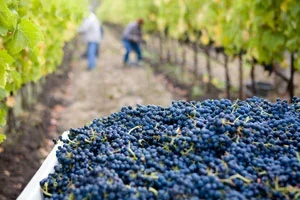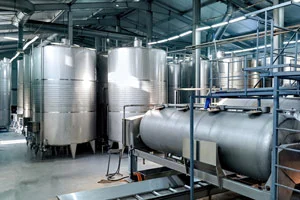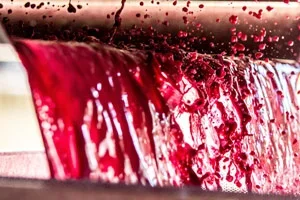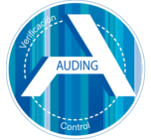Responsible winery
Technology for responsible winery
The harvest months are intense months that do not end with the harvesting of the grapes, but during which an infinite number of tasks converge in a short space of time in which all the grapes managed by the winery have to be supervised. This important workload makes the wineries seek to perfect the processes to achieve improvements in terms of quality, as well as optimization of both economic and energy resources.
- Process efficiency
- Energy savings
- Production capacity
- More quality in wine

Ulises
Efficient injection system (patented nationally and internationally) of pressurized gas in winemaking tanks, easy to operate thanks to the hardware and software designed by AGROVIN. Our experience has allowed us to optimize the pumping-over process of the fermenting mash, which can be automated depending on the value of the density, temperature or redox potential. These parameters can be modified by the user to adapt to the specific needs of each winery.
Tank Control
It allows the automation of different processes during winemaking in order to avoid doing them manually, which means less effort and ease of management and control, as well as significant savings in resources. It offers the possibility of automating the winemaking process and integrating different tools in such a way that the user can configure his equipment with the components he wants and expand it later according to his needs.
Tank Control offers the user the possibility of monitoring the tank by means of the following systems:
Density control
The density control system allows us to know the moment in which the fermentation process is in progress. By simply introducing the initial value of the must density, the equipment autonomously shows the evolution of each of the tanks through the representation of a density curve, allowing to know the evolution and possible deviations in a simple way. At the same time, the equipment allows with this mode to manage the temperature and the pumping-over cycles during fermentation.
Temperature control
It allows the measurement and optimal performance of the cooling system of the tank by controlling the activation of the cold/heat. Through the installation of two temperature probes, a more realistic knowledge of the tank situation can be obtained, with the possibility of activating additional pump-ups in case of stratification. I In addition, the two-point temperature monitoring makes the fermentation temperature more realistic. If there is a significant variation, an additional pumping up is carried out to achieve a correct homogenization of the entire volume contained in the tank.
Level control
The incorporation in the tank of an instrument to measure its volume becomes an excellent tool to have the gauging of the cellar in real time. The system is equipped with a light and sound alarm to warn if the must/wine reaches the maximum level.
ORP control
The measurement of the ORP in oenology makes it possible to predict whether the wine is at risk of oxidation (high potentials) or reduction (low potentials). Depending on this value, a more intelligent management of the oxygen supply in the medium during winemaking can be carried out. Knowing the range of values within which this parameter, the potential, must be maintained during winemaking and controlling the oxygen supply to keep it within the limit values, a safer and more appropriate winemaking for the type of product will be achieved. The program generates a graph showing the evolution curve of the potential during fermentation.
Oxygen dosing
Oxygen dosing Oxygen management is an essential tool to ensure that its action on the winemaking process is always positive, contributing to wine stability and quality. This system allows the precise dosage of oxygen in the wine by means of macro/micro-oxygenation techniques. In this way, the winemaking process is protected, perfected and qualitatively improved. It will work in synergy with the ORP system, making possible the intelligent management of
All these tools can work individually or in synergy with each other. The winemaker will be able to efficiently monitor the fermentation process because it is possible to intelligently manage multiple tanks from a single control point.
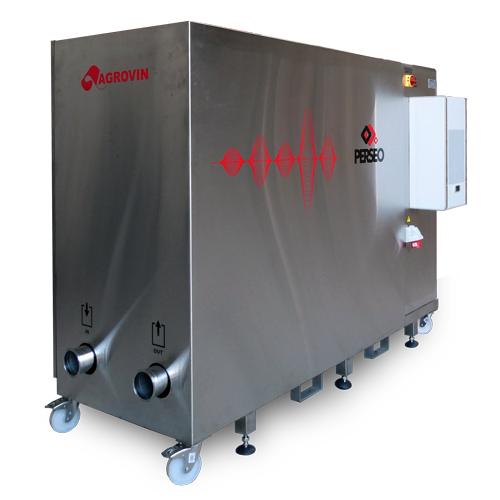
Ultrawine Perseo
Revolutionary technological system that allows extracting the maximum potential from the grapes through the use of high power and low frequency ultrasound. In addition, its application cancels the effects of climate change on the grape maturity lag, controlling the alcohol content and enhancing the quality of the grapes to obtain a high quality wine.
It is an eco-sustainable system that responds to the need of wineries to reduce the use of energy and resources in the winemaking process, without sacrificing quality, since, compared to the traditional maceration method, Ultrawine-Perseo reduces maceration time by up to 50% and 15% in terms of energy savings, due to the low consumption of its components and the fact that it does not require the use of temperature for extraction.
Oxi_Out
There are numerous methodologies for the control of dissolved gases in winemaking before bottling, but the development of Oxi_Out technology has provided a highly efficient tool at the industrial level. This system, patented in 2009, allows efficient management of oxygen and carbon dioxide. Through the selective elimination of oxygen, the life of the wines will be longer, avoiding their evolution over long periods of time.
On the other hand, the correct management of CO2 will enhance the freshness of white and rosé wines or soften the aggressiveness of the more astringent wines from unripe green grapes.

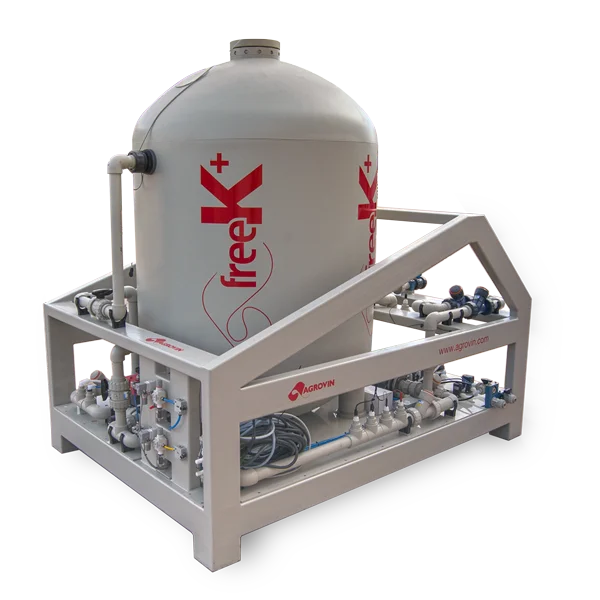
“The OIV, through Resolutions Oeno 442/2012 and Oeno 443/2012 and the European Union, through Regulation 144/2013, accept and authorize the use of Cation Exchange as an alternative method in the acidification of musts and wines.”
FreeK+
Due to the edaphoclimatic characteristics and even more to the long periods of drought that have increased in the last decade due to climate change, the vine, through its root system, looks for water in the most superficial areas, areas rich in K+. This causes the berries to be loaded with this cation, which causes the dreaded tartaric instability.
After years of research and continuous improvement, Agrovin commercializes a unique system on the market called Freek+ System. The basis of this type of equipment is based on cation exchange: substitution of ions of the same sign between a mobile phase, the wine, and a stationary phase, the resin, through its functional groups.
The Freek System contributes to tartaric stability due to the selective elimination of K+ ions. It also produces the acidification of musts and wines: the concentration of free H+ ions is responsible for the pH of the wine, therefore, the substitution of metal cations by protons causes an increase in total acidity and a decrease in pH.
